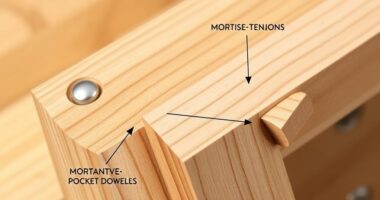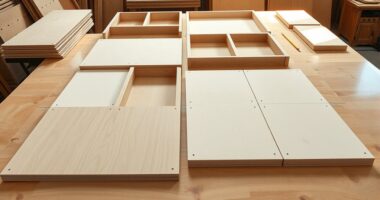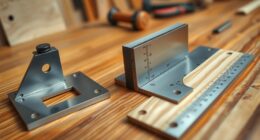A well-designed toe kick enhances your ergonomics by creating space at the base of cabinets, letting you stand closer and reducing back and knee strain. It should be about 3.5 inches high and seamlessly blend with the cabinet for a sleek look. Use durable materials like MDF or plywood, secured with appropriate fasteners for stability. Attention to detail during construction guarantees lasting comfort and style—continue to explore for more tips on perfecting your toe-kick design.
Key Takeaways
- Toe kicks create space at cabinetry bases, improving ergonomic comfort by allowing closer standing positions and reducing strain.
- Proper construction involves precise measurements, quality materials, and secure fastening to ensure durability and stability.
- Typical toe kick height is around 3.5 inches, with finishing details like bevels or rounded edges for safety and aesthetics.
- Material choices such as MDF or plywood, finished with paint or laminate, enhance longevity and seamless integration with cabinetry.
- Thoughtful toe-kick design enhances user comfort, overall aesthetics, and the functional efficiency of kitchen cabinetry.

Ever wondered how to enhance both the style and functionality of your cabinetry? The answer lies in thoughtful toe-kick design, which seamlessly combines ergonomic benefits with precise construction techniques. Your cabinets aren’t just about looks; they should also be comfortable and practical for everyday use. That’s where a well-designed toe kick makes a real difference. It creates a space at the base of your cabinetry that allows you to stand closer without discomfort, reducing strain on your back and knees. This small but impactful feature improves your overall ergonomic experience, especially during prolonged periods of kitchen work or cleaning. When you focus on the ergonomic benefits of a toe kick, you’re prioritizing user comfort and efficiency, making your space more inviting and functional. Proper construction also involves attention to security and stability, ensuring the toe kick remains firmly in place over time.
Achieving this starts with understanding the right construction techniques. Properly incorporating a toe kick involves precise measurements and careful planning. Typically, a standard toe kick is about 3.5 inches high and runs along the entire length of your base cabinets. Using quality materials and secure fastening methods ensures durability and stability. You want the toe kick to blend seamlessly with the rest of your cabinetry, so attention to detail during installation is essential. You might also consider adding a slight bevel or rounded edge to eliminate sharp corners, which enhances safety and comfort during use. Construction techniques like using cleats or brackets to attach the toe kick panel help keep it firmly in place and prevent squeaks or looseness over time.
Another critical aspect is the material choice. Many opt for durable, easy-to-clean materials such as MDF or plywood, finished with paint, veneer, or laminate that matches or complements the cabinet finish. This not only improves the aesthetic appeal but also ensures longevity, especially in high-traffic areas like kitchens. When you pay attention to these details, your toe kick becomes an integrated part of your cabinetry’s design, elevating both form and function.
Incorporating a well-designed toe kick isn’t just about aesthetics—it’s about creating a space that’s easier to use and more comfortable. When you understand the ergonomic benefits and employ proper construction techniques, you’re crafting cabinetry that feels better to work around and looks sleek and finished. It’s a subtle detail that can considerably impact your daily routines, making your kitchen more user-friendly and stylish at the same time. So, next time you plan new cabinetry or upgrade existing pieces, give serious thought to your toe kick design—it’s a small feature with a big impact.
Frequently Asked Questions
How Do Toe-Kick Heights Vary for Different User Heights?
You can customize toe-kick heights based on your height to enhance ergonomic standing comfort. Taller users typically prefer higher toe-kicks, around 4 to 6 inches, to reduce bending, while shorter users benefit from lower heights, around 2 to 3 inches, for easier access. Adjusting toe-kick height guarantees ergonomic standing and better accessibility, making the kitchen more comfortable for everyone. Always measure your user height to determine the most suitable toe-kick height for your needs.
What Materials Are Best for Durable Toe-Kick Construction?
For durable toe-kick construction, you should select materials based on durability factors like impact resistance and moisture resistance. Solid hardwoods, high-quality plywood, or dense MDF are excellent choices because they withstand daily wear and tear. You might also consider metal options like stainless steel or aluminum for extra strength. Prioritize materials that resist damage and moisture, ensuring your toe-kick remains sturdy and long-lasting over time.
How Does Toe-Kick Design Affect Kitchen Cleaning Ease?
A tidy, accessible toe kick makes kitchen cleaning simple and straightforward. When designed with smooth surfaces and enough clearance, it allows you to easily reach beneath cabinets, removing dust and debris. Proper toe-kick accessibility reduces the hassle of deep cleaning, preventing grime buildup and enhancing hygiene. By prioritizing practicality in toe-kick design, you guarantee your kitchen stays clean, comfortable, and clutter-free with minimal effort and maximum ease.
Are There Standard Dimensions for Commercial Toe-Kicks?
Yes, there are standard dimensions for commercial toe-kicks, typically around 3.5 inches in height and 3 inches in depth. These dimensions are based on ergonomic considerations to guarantee comfort and ease of movement for users. When designing or selecting toe-kicks, you should prioritize these standards to optimize accessibility, reduce fatigue, and maintain a consistent, professional look across commercial kitchens or workspace environments.
How Can I Retrofit an Existing Cabinet With a Toe-Kick?
To retrofit your existing cabinet with a toe kick, first reinforce the cabinet base to support the new toe-kick. Measure the standard dimensions or customize to your needs. Attach a toe-kick panel securely, ensuring it’s level. Consider adding toe kick lighting for better visibility. Reinforcing the cabinet guarantees stability, while lighting enhances functionality, making your space more ergonomic and visually appealing.
Conclusion
In the world of cabinet design, the toe-kick acts like a silent guardian, quietly elevating your comfort and functionality. When you pay attention to its ergonomics and construction, you’re crafting a foundation as steady as a heartbeat, guiding your space toward harmony. Don’t overlook this small detail—think of it as the gentle push that keeps your kitchen flowing smoothly. With thoughtful design, your cabinets become more than just furniture—they become a seamless part of your daily rhythm.









